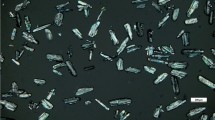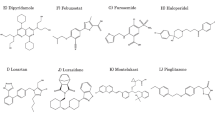Abstract
In this paper, a novel formulation of dual-release dry suspension of mosapride citrate (DRDS-MC) was designed which can be quickly released in the stomach while having sustained-release effect. Co-grinding mixture of mosapride citrate (MC) together with L-HPC as hydrophilic excipient was prepared in order to improve the solubility of MC. The co-grinding mixture was characterized by solubility studies, DSC, X-RD, SEM, FTIR, and size distribution before the preparation of the DRDS-MC. Then, the co-grinding mixture was used to prepare DRDS-MC via wet granulation method. The evaluation of DRDS-MC was focused on physicochemical properties, intestinal absorption, and pharmacokinetics. The results of DSC, X-RD, SEM, FTIR, and size distribution indicated that MC resides in co-grinding mixture with no crystalline changes, hydrogen bonds made L-HPC greatly improving the solubility of MC. Then, the dissolution of DRDS-MC reached 70% in pH 1.2 within 2 h, and the 12-h dissolution of MC in pH 6.8 was nearly 80%. The sedimentation volume after 3 h was 0.94 and redispersibility was good. The linear regression equation between in vitro release of DRDS-MC and intestinal absorption fraction in rats was: Y = 29.215 + 47.535*X (r = 0.952). At last, pharmacokinetic studies in beagle dogs demonstrated that DRDS-MC has prolonged effect compared with commercial formulation Gasmotin as a reference. All results indicated that the DRDS-MC could be quickly released in the stomach while having sustained-release effect.













Similar content being viewed by others
References
Quigley EM. Prokinetics in the management of functional gastrointestinal disorders. Curr Gastroenterol Rep. 2017;19(10):53.
Lyubashina O, Sivachenko I. The 5-HT4 receptor-mediated inhibition of visceral nociceptive neurons in the rat caudal ventrolateral medulla. Neuroscience. 2017;359:277–88.
Yang YJ, Bang CS, Baik GH, Park TY, Shin SP, Suk KT, et al. Prokinetics for the treatment of functional dyspepsia: Bayesian network meta-analysis. BMC Gastroenterol. 2017;17(1):83.
Aggarwal A, Bhatt M. Commonly used gastrointestinal drugs. Handb Clin Neurol: Elsevier; 2014. p. 633–43.
Iida H, Kaai M, Inoh Y, Kanoshima K, Ohkuma K, Nonaka T, et al. Early effect on intragastric pH of oral administration of rabeprazole with mosapride compared with rabeprazole alone. Ann Gastroenterol. 2017;30(4):424–8.
Wu T, Wang G, Shi C, Li J, Zhao N, Dong Z, et al. Development and evaluation of orally disintegrating tablet containing mosapride resin complex. Acta Pharma. 2018;68(2):159–70.
Morsi NM, Abdelbary GA, Elshafeey AH, Ahmed MA. Engineering of a novel optimized platform for sublingual delivery with novel characterization tools: in vitro evaluation and in vivo pharmacokinetics study in human. Drug Deliv. 2017;24(1):918–31.
Zhao L, Sun X, Xiong Z, Wang S. Simultaneous determination of mosapride and its active des-p-fluorobenzyl and 4′-N-oxide metabolites in rat plasma using UPLC–MS/MS: an application for a pharmacokinetic study. Talanta. 2015;137:130–5.
Huang J, Tian Y, Zhang Z-J, Li J, Cao X. Pharmacokinetics and bioequivalence study of two mosapride citrate formulations after single-dose administration in healthy Chinese male volunteers. Arzneimittelforschung. 2011;61(03):167–72.
Chae JW, Song BJ, Baek IH, Yun HY, Ma J, Kwon KI. Effects of food intake on pharmacokinetics of mosapride in beagle dogs. J Vet Pharmacol Ther. 2015;38(5):497–9.
Lim HC, Kim J-H, Youn YH, Lee EH, Lee BK, Park H. Effects of the addition of mosapride to gastroesophageal reflux disease patients on proton pump inhibitor: a prospective randomized, double-blind study. J Neurogastroenterol. 2013;19(4):495–502.
Lee JY, Kim SK, Cho KB, Park KS, Kwon JG, Jung JT, et al. A double-blind, randomized, multicenter clinical trial investigating the efficacy and safety of esomeprazole single therapy versus mosapride and esomeprazole combined therapy in patients with esophageal reflux disease. J Neurogastroenterol. 2017;23(2):218–28.
Goyal S, Agarwal G, Agarwal S, Karar P. Oral sustained release tablets: an overview with a special emphasis on matrix tablet. Am J Drug Deliv. 2017;5(2).
Li Y, Liu J, Liu K, Wang Y, Zhou Y, Xu Y, et al. Intestinal absorption characters of mosapride citrate using caco-2 cells and single-pass intestinal perfusion methods. Chin Pharm J. 2017;52(17):1519–24.
Fagerholm U, Johansson M, Lennernäs H. Comparison between permeability coefficients in rat and human jejunum. Pharm Res. 1996;13(9):1336–42.
Yoshikawa T, Yoshida N, Mine Y, Hosoki K. Affinity of mosapride citrate, a new gastroprokinetic agent, for 5-HT4 receptors in guinea pig ileum. Jpn J Pharmacol. 2001;77(1):53–9.
Gomaa NA, Ibrahim HM, Ishii M, Nassif MN, El-khodery SA. Dose-dependent effects of mosapride citrate on duodenal and cecal motility in donkeys (Equus asinus). Int J Vet Sci Med. 2013;1(2):51–6.
Sasaki N, Lee I, Ayukawa Y, Yamada H. Effects of orally administrated mosapride, a 5-HT4 receptor agonist on the digestive tract of horses. J Equine Sci. 2004;15(3):81–4.
Schiele JT, Quinzler R, Klimm H-D, Pruszydlo MG, Haefeli WE. Difficulties swallowing solid oral dosage forms in a general practice population: prevalence, causes, and relationship to dosage forms. Eur J Clin Pharmacol. 2013;69(4):937–48.
Du Y, Zhai Y, Zhang J, Wu C, Luo C, Sun J, et al. Development and evaluation of taste-masked dry suspension of cefuroxime axetil for enhancement of oral bioavailability. Asian J Pharm Sci. 2013;8(5):287–94.
Rao MR, Bhingole RC. Nanosponge-based pediatric-controlled release dry suspension of Gabapentin for reconstitution. Drug Dev Ind Pharm. 2015;41(12):2029–36.
Pongsamart K, Kleinebudde P, Puttipipatkhachorn S. Preparation of fenofibrate dry emulsion and dry suspension using octenyl succinic anhydride starch as emulsifying agent and solid carrier. Int J Pharm. 2016;498(1–2):347–54.
Sattar A, Chen D, Jiang L, Pan Y, Tao Y, Huang L, et al. Preparation, characterization and pharmacokinetics of cyadox nanosuspension. Sci Rep. 2017;7(1):2289.
Routes AE. Drug absorption, distribution and elimination; pharmacokinetics. 2015.
Lu B, Wang Y, Wang D, Gu X, Wang Y, Li X. Study on the improvement of dissolution of mosapride citrate by co-grinding method. WCJ·PS. 2016;31(2):132–5.
Li X, Wang Y, Lu B, Wang D. Co-grinding of mosapride citrate, preparation method thereof and pharmaceutical composition. CN Patents. 2015;104546686 (A).
Guo B, Liu H, Li Y, Zhao J, Yang D, Wang X, et al. Application of phospholipid complex technique to improve the dissolution and pharmacokinetic of probucol by solvent-evaporation and co-grinding methods. Int J Pharm. 2014;474(1):50–6.
Dezani TM, Dezani AB, da Silva Junior JB, dos Reis Serra CH. Single-pass intestinal perfusion (SPIP) and prediction of fraction absorbed and permeability in humans: a study with antiretroviral drugs. Eur J Pharm Biopharm. 2016;104:131–9.
Sun M, Zhai X, Xue K, Hu L, Yang X, Li G, et al. Intestinal absorption and intestinal lymphatic transport of sirolimus from self-microemulsifying drug delivery systems assessed using the single-pass intestinal perfusion (SPIP) technique and a chylomicron flow blocking approach: linear correlation with oral bioavailabilities in rats. Eur J Pharm Sci. 2011;43(3):132–40.
Kumar AH, Clover AJ. Intraperitoneal co-administration of low dose urethane with xylazine and ketamine for extended duration of surgical anesthesia in rats. Lab Anim Res. 2015;31(4):174–9.
Wahajuddin SSP, Patel K, Pradhan T, Siddiqui HH, Singh SK. Prediction of human absorption of a trioxane antimalarial drug (CDRI 99/411) using an in-house validated in situ single-pass intestinal perfusion model. Arzneimittelforschung. 2011;61(09):532–7.
Chakraborty S, Yadav L, Aggarwal D. Prediction of in vivo drug performance using in vitro dissolution coupled with STELLA: a study with selected drug products. Drug Dev Ind Pharm. 2015;41(10):1667–73.
Wang Q, Hu C, Zhang H, Zhang Y, Liu T, Qian A, et al. Evaluation of a new solid non-aqueous self-double-emulsifying drug-delivery system for topical application of quercetin. J Microencapsul. 2016;33(8):785–94.
Hughey JR, Keen JM, Bennett RC, Obara S, McGinity JW. The incorporation of low-substituted hydroxypropyl cellulose into solid dispersion systems. Drug Dev Ind Pharm. 2015;41(8):1294–301.
Hussain A, Smith G, Khan KA, Bukhari NI, Pedge NI, Ermolina I. Solubility and dissolution rate enhancement of ibuprofen by co-milling with polymeric excipients. Eur J Pharm Sci. 2018;123:395–403.
Gupta MK, Vanwert A, Bogner RH. Formation of physically stable amorphous drugs by milling with Neusilin. J Pharm Sci. 2003;92(3):536–51.
Dahlgren D, Roos C, Sjogren E, Lennernas H. Direct in vivo human intestinal permeability (Peff ) determined with different clinical perfusion and intubation methods. J Pharm Sci. 2015;104(9):2702–26.
Xu Y, Wang Y, Li XM, Huang Q, Chen W, Liu R, et al. Study on the release of fenofibrate nanosuspension in vitro and its correlation with in situ intestinal and in vivo absorption kinetics in rats. Drug Dev Ind Pharm. 2014;40(7):972–9.
Buch P, Langguth P, Kataoka M, Yamashita S. IVIVC in oral absorption for fenofibrate immediate release tablets using a dissolution/permeation system. J Pharm Sci. 2009;98(6):2001–9.
Funding
This work was financially supported by the Jiangsu Synergetic Innovation Center for Advanced Bio-Manufacture (Nos.XTD1820) and the Postgraduate Research & Practice Innovation Program of Jiangsu Province (Nos.KYCX18_1104, KYCX18_1115).
Author information
Authors and Affiliations
Corresponding authors
Additional information
Publisher’s Note
Springer Nature remains neutral with regard to jurisdictional claims in published maps and institutional affiliations.
Highlights
• Co-grinding mixture was prepared by mosapride citrate (MC) and L-HPC, and hydrogen bonds may be the reason for enhancing the hydrophilic of L-HPC which greatly improved the water solubility of MC.
• Dual-release dry suspension of mosapride citrate (DRDS-MC) was prepared.
• The dissolution of DRDS-MC reached 70% in pH1.2 within 2 h and the 12 h dissolution of MC in pH6.8 was nearly 80%. DRDS-MC could quickly release in acid medium and has sustained-release effect in pH6.8.
• The linear regression equation between in vitro release of DRDS-MC and intestinal absorption fraction in rats was: Y=29.215+47.535*X (r=0.952).
• Pharmacokinetic results proved that DRDS-MC had long-term sustained-release effect compared with commercial formulation Gasmotin in beagle dogs.
Rights and permissions
About this article
Cite this article
Liu, K., Meng, Z., Li, Y. et al. Preparation and Evaluation of Mosapride Citrate Dual-Release Dry Suspension. AAPS PharmSciTech 20, 155 (2019). https://doi.org/10.1208/s12249-019-1343-x
Received:
Accepted:
Published:
DOI: https://doi.org/10.1208/s12249-019-1343-x




